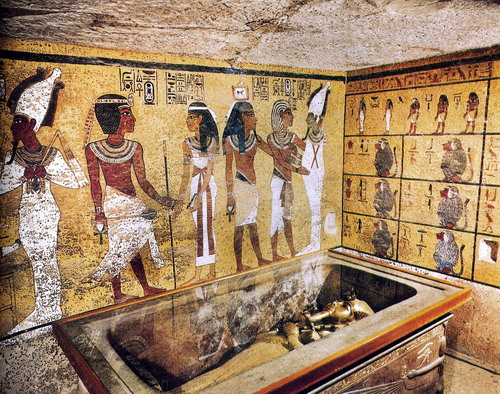Mummification
The earliest ancient Egyptians buried their dead in small pits in the desert. The heat and dryness of the sand dehydrated the bodies quickly, creating natural 'mummies'.
Later, the ancient Egyptians began burying their dead in coffins to protect them from wild animals in the desert. However, they realised that bodies placed in coffins decayed when they were not exposed to the hot, dry sand of the desert.

Watch the video explaining how mummies were made.
_______________________________________________________________________
Making a mummy

It took a long time to make a mummy and it was expensive, so only those in the royal family and rich people were mummified.
Some animals mummies were found. These were cats, dogs, birds, baboons and crocodiles that represented a god or goddess.
The process was performed by priests and it has three stages. First, the embalming of the body, then the wrapping and burial of the body.
Embalming
1. They washed the body with wine while they said prayers over the body. Then the priests would rub the body with oils and spices.
2. Then they made a cut in the left side of the body and removed many of the internal organs (it is important to remove them because they are the first part of the body to decompose).

The lungs, liver, stomach & intestines were placed in jars called canopic jars which represent the four sons of Horus. The jars were placed in the tomb with the mummy because the Egyptians believed that the person would need them in their next life. The heart was not taken out of the body because it was the centre of intelligence and feeling and the man would need it in the afterlife.
A long hook was used to smash the brain and pull it out through the nose.
3. The body was covered with natron or salt for forty (40) days to dry the body. The skin would toughen like leather.
Wrapping

4. Strips of linen that were soaked in resin were wrapped around the body. Priests would wrap good luck charms in between the layers.
The charms were called Amulets. They were usually gold and came in different shapes like hearts or scarabs (beetles). One popular Amulet was the Eye of Horus. They believed this charm would allow the body to see outside the wrappings.
The resin would dry in about 15 days. Sometimes a mask of the persons face was placed over the linens.
5. The body was then placed in a mummy case (or several) that were decorated with paintings of the person, or writings of prayers and magic spells.
6. Finally, the mummy was ready for the journey to the tomb.
The Funeral
The funeral procession followed a series of stops. The funeral was a big event. It was thought to see the person safely into the next life. It was also important that the procession be long.
Sometimes people were paid to walk in the procession and carry things they thought the person would need in their next life, such as food, drink, weapons, tools, musical instruments, furniture, etc.
Fun Facts about Egyptian Mummies
- Over the past few thousands of years, many of the Egyptian mummies have been destroyed in interesting ways. Some were burned for fuel, some were ground into powder to make magical potions, and some were destroyed by treasure hunters.
- The heart was left in the body because it was considered to be the center of intelligence. The brain was thrown away because it was thought to be useless.
- Sometimes the mummy's mouth would be opened to symbolize breathing in the afterlife. It is probably this custom that led to the superstition that mummies come back to life.
- Mummies are studied by scientists without unwrapping them by using CAT scan and X-Ray machines.
______________________________________________________________
Activity
Amulet Scarab
Make your own scarab. Use an oval-shaped bar of soap and a butterknife. Using the edge of the knife, draw an outline of a beetle on the top. Carve out the background so the beetle is raised from the soap.






